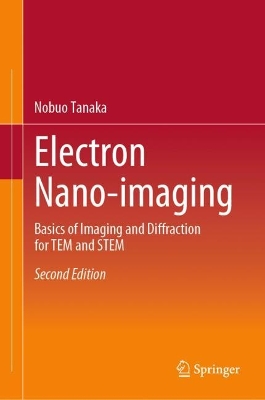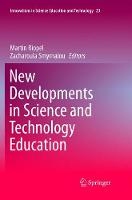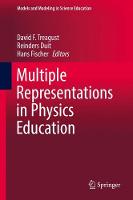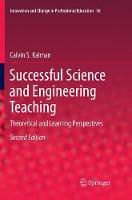Multiple Representations in Physics Education
 -15%
portes grátis
-15%
portes grátis
Multiple Representations in Physics Education
Duit, Reinders; Treagust, David F.; Fischer, Hans E.
Springer International Publishing AG
09/2018
322
Mole
Inglês
9783319865089
15 a 20 dias
516
Descrição não disponível.
Chapter 1 Multiple Representations in Physics And Science Education - Why Should we Use Them? Maria Opfermann, Annett Schmeck and Hans E. Fischer.- Section A. Multiple Representations: Focus on Models and Analogies, Reinders Duit.- Chapter 2 Teaching and Learning Representations in Upper Secondary Physics, Per Morten Kind, Carl Angell, Oystein Guttersrud.- Chapter 3 Integrating Computational Artifacts into the Multi-Representational Toolkit of Physics Education, Brian E. Gravel, Michelle H. Wilkerson.- Chapter 4 Evaluating Multiple Analogical Representations from Students' Perceptions, Jing-Wen Lin, Mei-Hung Chiu.- Section B Multiple Representations: Focus on Multiple Modes, Hans Fischer.- Chapter 5 Social Semiotics in University Physics Education, John Airey, Cedric Linder.- Chapter 6 Learning Optics with Multiple Representations: Not as Simple as Expected, Yen-Ruey Kuo, Mihye Won, Marjan Zadnik, Salim Siddiqui, David Treagust.- Chapter 7 Enacting a Representation Construction Approach to Teaching And Learning Astronomy, Peter Hubber, Russell Tytler.- Chapter 8 Learning about Forces using Representations, Pasi Nieminen, Antti Savinainen, Jouni Viiri.- Chapter 9 The Conceptual elements of Multiple Representations: A Study of Textbooks' Representations of Electric Current, Chee Leong Wong, Hye-Eun Chu.- Section 3: Multiple Representations: Focus on Reasoning and Representational Competence, David Treagust.- Chapter 10 Representational Competence, Understanding of Experiments, Phenomena and Basic Concepts in Geometrical Optics: A Representational Approach, Andreas Mueller, Rosa Hettmannsperger, Jochen Scheid, Wolfgang Schnotz.- Chapter 11 Understanding and Promoting Effective Use of Representations in Physics Learning, Pat Kohl, Noah Finkelstein.- Chapter 12 The Role of Representations in Students' Explanations of Four Phenomena in Physics : Dynamics, thermal physics and electromagnetic induction and superposition, Jennifer Yeo, John K. Gilbert.- Chapter 13Cross Referencing to Co-Construct Knowledge about Global Heat Transfer in an Online Learning Environment: Learning with Multiple Visualizations, Florence R. Sullivan, W. Richards Adrion, Dave Hart, Christopher N. Hill, K.C. Nat Turner, Jeff Xavier, Youngkwan Cha, Sangchil Lee, Bradford Wheeler.- Index.
Este título pertence ao(s) assunto(s) indicados(s). Para ver outros títulos clique no assunto desejado.
Analogies in physics;Cognitive load;Conceptual change;Higher order thinking skills;Learning physics;Models in physics;Multi-modal learning;Multi-modal teaching;Multiple visualizations;Physics concepts;Physics curriculum;Physics phenomena;Reasoning skills;Representational competence;Scaffolding;Secondary physics curriculum;Student assessment;Student's explanation;Teaching physics;University physics curriculum
Chapter 1 Multiple Representations in Physics And Science Education - Why Should we Use Them? Maria Opfermann, Annett Schmeck and Hans E. Fischer.- Section A. Multiple Representations: Focus on Models and Analogies, Reinders Duit.- Chapter 2 Teaching and Learning Representations in Upper Secondary Physics, Per Morten Kind, Carl Angell, Oystein Guttersrud.- Chapter 3 Integrating Computational Artifacts into the Multi-Representational Toolkit of Physics Education, Brian E. Gravel, Michelle H. Wilkerson.- Chapter 4 Evaluating Multiple Analogical Representations from Students' Perceptions, Jing-Wen Lin, Mei-Hung Chiu.- Section B Multiple Representations: Focus on Multiple Modes, Hans Fischer.- Chapter 5 Social Semiotics in University Physics Education, John Airey, Cedric Linder.- Chapter 6 Learning Optics with Multiple Representations: Not as Simple as Expected, Yen-Ruey Kuo, Mihye Won, Marjan Zadnik, Salim Siddiqui, David Treagust.- Chapter 7 Enacting a Representation Construction Approach to Teaching And Learning Astronomy, Peter Hubber, Russell Tytler.- Chapter 8 Learning about Forces using Representations, Pasi Nieminen, Antti Savinainen, Jouni Viiri.- Chapter 9 The Conceptual elements of Multiple Representations: A Study of Textbooks' Representations of Electric Current, Chee Leong Wong, Hye-Eun Chu.- Section 3: Multiple Representations: Focus on Reasoning and Representational Competence, David Treagust.- Chapter 10 Representational Competence, Understanding of Experiments, Phenomena and Basic Concepts in Geometrical Optics: A Representational Approach, Andreas Mueller, Rosa Hettmannsperger, Jochen Scheid, Wolfgang Schnotz.- Chapter 11 Understanding and Promoting Effective Use of Representations in Physics Learning, Pat Kohl, Noah Finkelstein.- Chapter 12 The Role of Representations in Students' Explanations of Four Phenomena in Physics : Dynamics, thermal physics and electromagnetic induction and superposition, Jennifer Yeo, John K. Gilbert.- Chapter 13Cross Referencing to Co-Construct Knowledge about Global Heat Transfer in an Online Learning Environment: Learning with Multiple Visualizations, Florence R. Sullivan, W. Richards Adrion, Dave Hart, Christopher N. Hill, K.C. Nat Turner, Jeff Xavier, Youngkwan Cha, Sangchil Lee, Bradford Wheeler.- Index.
Este título pertence ao(s) assunto(s) indicados(s). Para ver outros títulos clique no assunto desejado.
Analogies in physics;Cognitive load;Conceptual change;Higher order thinking skills;Learning physics;Models in physics;Multi-modal learning;Multi-modal teaching;Multiple visualizations;Physics concepts;Physics curriculum;Physics phenomena;Reasoning skills;Representational competence;Scaffolding;Secondary physics curriculum;Student assessment;Student's explanation;Teaching physics;University physics curriculum







